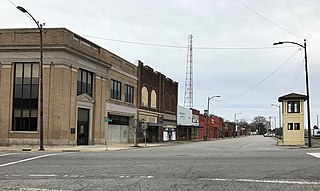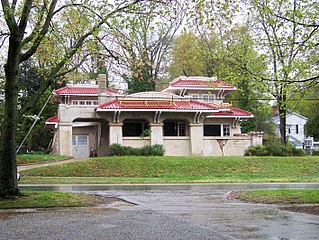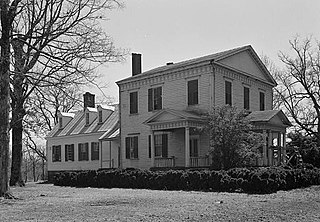
Enfield is a town in Halifax County, North Carolina, United States, and was founded in 1740. As of the 2020 census, the town's population was 1,864, which reflected a decrease of almost 27% from the population of 2,538 in 2010. It is the oldest town in Halifax County, North Carolina, and was once the world’s largest raw peanut market. Enfield is part of the Roanoke Rapids, North Carolina Micropolitan Statistical Area.

Roseland Plantation is a historic plantation complex site in Faunsdale, Alabama. The site is situated on a low hill at the end of a long driveway on the overgrown estate. It was added to the National Register of Historic Places on January 20, 1994, as a part of the Plantation Houses of the Alabama Canebrake and Their Associated Outbuildings Multiple Property Submission.
The John Watson House, now called The HistoricMagnolia Manor, also known as Burwell House is a historic plantation house located at Warrenton, Warren County, North Carolina.

This list includes properties and districts listed on the National Register of Historic Places in Warren County, North Carolina. Click the "Map of all coordinates" link to the right to view a Google map of all properties and districts with latitude and longitude coordinates in the table below.

Jacob W. Holt was an American carpenter and builder-architect in Warrenton, North Carolina. Some twenty or more buildings are known to have been built by him or are attributed to him and his workshop by local tradition or their distinctive style. Some of his work includes among others Long Grass Plantation, Eureka near Baskerville, Virginia; Shadow Lawn at Chase City, Virginia; buildings at Peace College; Vine Hill near Centerville, North Carolina; Dr. Samuel Perry House near Gupton, North Carolina; the Archibald Taylor House near Wood, North Carolina; Salem Methodist Church near Huntsboro, North Carolina; Hebron Methodist Church in Warren County, North Carolina; and the John Watson House and possibly the house known as Annefield in Charlotte County, Virginia, and Belvidere and Pool Rock Plantation near Williamsboro, North Carolina. He may have also built the Forestville Baptist Church at Forestville, North Carolina.

The Stone Plantation, also known as the Young Plantation and the Barton Warren Stone House, is a historic Greek Revival-style plantation house and one surviving outbuilding along the Old Selma Road on the outskirts of Montgomery, Alabama. It had been the site of a plantation complex, and prior to the American Civil War it was known for cotton production worked by enslaved people.

Warrenton is a town in, and the county seat of, Warren County, North Carolina, United States. The population was 862 at the 2010 census. Warrenton, now served by U.S. routes 158 and 401, was founded in 1779. It became one of the wealthiest towns in the state from 1840 to 1860, being a trading center of an area of rich tobacco and cotton plantations. It has a large stock of historic architecture buildings. More than 90 percent of its buildings are listed in the National Register of Historic Places and its National Historic District encompasses nearly half its area.

Samuel Harrison Reed House is a historic home located at Biltmore Village, Asheville, Buncombe County, North Carolina. It was built in 1892, and is a Queen Anne style dwelling.

Tate House, also known as The Cedars, is a historic home located at Morganton, Burke County, North Carolina. The core was built about 1850, and is a two-story, three bay, brick mansion with a center hall plan in the Greek Revival style. It was remodeled in the Second Empire style in 1868, with the addition of a mansard roof and large three-story octagonal tower. It was the home of Samuel McDowell Tate (1830–1897), who undertook the 1868 remodeling.

Franklin Pierce Tate House is a historic home located at Morganton, Burke County, North Carolina. It was designed by architect Electus D. Litchfield and completed in 1928. It is a two-story, Colonial Revival style dwelling constructed of irregularly-coursed, rock-faced granite blocks.

Warren House and Warren's Store is a historic house and store and national historic district located at Prospect Hill, Caswell County, North Carolina. The house was built about 1858, and is a two-story, three bay, Greek Revival style frame dwelling. It is set on a brick foundation and has a low hipped roof. The front facade features a two-story, three bay, pedimented porch. Warren's Store and Post Office is located across from the house and is a two-story rectangular brick building of vernacular Greek Revival temple-form design. Also on the property is the contributing kitchen building.

West Warren Street Historic District is a national historic district located at Shelby, Cleveland County, North Carolina. It encompasses 176 contributing buildings, one contributing site, and one contributing object in a residential section of Shelby. The houses date between about 1918 and the 1940s, and include representative examples of Late Victorian, Queen Anne, and Bungalow / American Craftsman architectural styles. Notable nonresidential buildings include the Graham Elementary School drinking fountain (1927–1928) and Young Brothers Storage Building (1940s).

Dr. Samuel Perry House is a historic plantation house located near Gupton, Franklin County, North Carolina. It was built about 1857, and is a two-story, three bay, four-square Italianate / Greek Revival style frame dwelling. It is sheathed in weatherboard and has a hipped roof. It was built by noted American carpenter and builder Jacob W. Holt (1811-1880).

Manson is an unincorporated community in Warren County, North Carolina, United States. The community is located on U.S. Route 1, 5 miles (8.0 km) west-southwest of Norlina. Manson has a post office with ZIP code 27553.

Elgin is a historic plantation house located near Warrenton, Warren County, North Carolina. It was built about 1835, and is a two-story, three bay, Federal style temple-form frame dwelling. It has a gable roof, pedimented front porch, and flanking porches. At the rear is an earlier 1+1⁄2-story frame dwelling with a gable roof. The front facade features a Palladian entrance with sidelights and Tuscan colonnettes. The house is similar in style to Dalkeith.
Little Manor, also known as Mosby Hall, is a historic plantation house located in Warren County, North Carolina near the town of Littleton. It was built about 1804, and is a Federal style frame dwelling consisting of a two-story, five bay, pedimented main block flanked by one-story wings. It has a pedimented center bay front porch with Doric order pilasters and an older two-story rear wing, dated to about 1780.

Green Duke House is a historic plantation house located at Soul City, near Manson, Warren County, North Carolina. It was built about 1800 as a Georgian style dwelling, and remodeled in the post-Victorian style about 1900. It is a two-story, five bay, frame dwelling with a hipped roof. The front and rear facades feature one-story porches with elaborate Ionic order columns. At the time of its listing, the house was being used as a day care center.

Sledge-Hayley House is a historic home located at Warrenton, Warren County, North Carolina. It was built between 1852 and 1855, and is a two-story, three bay, Greek Revival style rectangular frame dwelling. It has a hipped roof with deep overhang and sits on a brick basement. The front facade has a one-bay entrance porch supported by two unfluted Doric order columns.

The Port Murray Historic District is a historic district in the Port Murray section of Mansfield Township, Warren County, New Jersey. It was an important transportation location, being on the Morris Canal and the Morris and Essex Railroad. The district was added to the National Register of Historic Places on June 7, 1996 for its significance in community development, architecture, and transportation from 1828 to 1915.

Pleasant Valley is an unincorporated community located in Washington Township, Warren County, New Jersey, west of Washington, along the Pohatcong Creek. The hamlet was built around a mill on the creek during the mid-18th century. The Pleasant Valley Historic District, encompassing the village, is listed on the state and national registers of historic places.






















